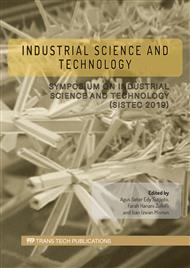[1]
M. Muthukrishnan, C. Shanthi, S. Selvasekarapandian, R. Manjuladevi, P. Perumal,P. Chrishtopher Selvin, Synthesis and characterization of pectin-based biopolymer electrolyte for electrochemical applications. Ionics (2018) 1-12.
DOI: 10.1007/s11581-018-2568-5
Google Scholar
[2]
N.F. Mazuki, A.F. Fuzlin, M.A. Saadiah A.S. Samsudin, An investigation on the abnormal trend of the conductivity properties of CMC/PVA-doped NH4Cl-based solid biopolymer electrolyte system. Ionics (2018) 1-11.
DOI: 10.1007/s11581-018-2734-9
Google Scholar
[3]
M. Fertah, A. Belfkira, M. Taourirte,F. Brouillette, Extraction and characterization of sodium alginate from Moroccan Laminaria digitata brown seaweed. Arab J Chem 10 (2017) S3707-S14.
DOI: 10.1016/j.arabjc.2014.05.003
Google Scholar
[4]
M. Jha, G. Chakraborty, S. Bardhan, B. Debnath S.K. Saha, Unperturbed dimension, interaction parameters, zeta potential and rheology of sodium alginate in binary solvent mixtures. Journal of Polymer Research 23 (2016) 162.
DOI: 10.1007/s10965-016-1057-7
Google Scholar
[5]
R. Karthik,S. Meenakshi, Removal of Cr (VI) ions by adsorption onto sodium alginate-polyaniline nanofibers. Int J Biol Macromol 72 (2015) 711-17.
DOI: 10.1016/j.ijbiomac.2014.09.023
Google Scholar
[6]
A. Pawlicka, F.C. Tavares, D.S. Dörr, C.M. Cholant, F. Ely, M.J.L. Santos C.O. Avellaneda, Dielectric behavior and FTIR studies of xanthan gum-based solid polymer electrolytes. Electrochim Acta 305 (2019) 232-39.
DOI: 10.1016/j.electacta.2019.03.055
Google Scholar
[7]
V. Moniha, M. Alagar, S. Selvasekarapandian, B. Sundaresan,G. Boopathi, Conductive bio-polymer electrolyte iota-carrageenan with ammonium nitrate for application in electrochemical devices. J Non-Cryst Solids 481 (2018) 424-34.
DOI: 10.1016/j.jnoncrysol.2017.11.027
Google Scholar
[8]
S. Patel,R. Kumar, Synthesis and characterization of magnesium ion conductivity in PVDF based nanocomposite polymer electrolytes disperse with MgO. J Alloys Compd 789 (2019) 6-14.
DOI: 10.1016/j.jallcom.2019.03.089
Google Scholar
[9]
M. Hema, S. Selvasekerapandian, A. Sakunthala, D. Arunkumar,H. Nithya, Structural, vibrational and electrical characterization of PVA–NH4Br polymer electrolyte system. Physica B: Condens Matter 403 (2008) 2740-47.
DOI: 10.1016/j.physb.2008.02.001
Google Scholar
[10]
A.F. Fuzlin, N.M.J. Rasali A.S. Samsudin. Effect on Ammonium Bromide in dielectric behavior based Alginate Solid Biopolymer electrolytes; 2018, IOP Publishing.
DOI: 10.1088/1757-899x/342/1/012080
Google Scholar
[11]
N.M.J. Rasali, Y. Nagao A.S. Samsudin, Enhancement on amorphous phase in solid biopolymer electrolyte based alginate doped NH4NO3. Ionics (2018) 1-14.
DOI: 10.1007/s11581-018-2667-3
Google Scholar
[12]
M.L.H. Rozali, A.S. Samsudin M.I.N. Isa, Ion conducting mechanism of carboxy methylcellulose doped with ionic dopant salicylic acid based solid polymer electrolytes. Int J Appl 2 (2012) 113-21.
Google Scholar
[13]
P. Perumal, P.C. Selvin, S. Selvasekarapandian,P. Sivaraj, Structural and Electrical Properties of Bio-polymer Pectin with LiClO4 Solid Electrolytes for Lithium Ion Polymer Batteries. Mater, Today: Proceedings 8 (2019) 196-202.
DOI: 10.1016/j.matpr.2019.02.100
Google Scholar
[14]
M.S.A. Rani, N.A. Dzulkurnain, A. Ahmad N.S. Mohamed, Conductivity and dielectric behavior studies of carboxymethyl cellulose from kenaf bast fiber incorporated with ammonium acetate-BMATFSI biopolymer electrolytes. Int J Polym Anal Charact 20 (2015) 250-60.
DOI: 10.1080/1023666x.2015.1013176
Google Scholar
[15]
A.F.A. Fuzlin, N.S. Ismail, Y. Nagao A.S. Samsudin, Electrical Properties of A Novel Solid Biopolymer Electrolyte based on Algi-nate Incorporated with Citric Acid. Makara J Tech 23 (2019) 48-52.
DOI: 10.7454/mst.v23i1.3643
Google Scholar
[16]
K.S. Ngai, S. Ramesh, K. Ramesh J.C. Juan, Electrical, dielectric and electrochemical characterization of novel poly (acrylic acid)-based polymer electrolytes complexed with lithium tetrafluoroborate. Chem Phys Lett 692 (2018) 19-27.
DOI: 10.1016/j.cplett.2017.11.042
Google Scholar
[17]
H.J. Woo, S.R. Majid A.K. Arof, Dielectric properties and morphology of polymer electrolyte based on poly (ɛ-caprolactone) and ammonium thiocyanate. Mater Chem Phys 134 (2012) 755-61.
DOI: 10.1016/j.matchemphys.2012.03.064
Google Scholar
[18]
N. Vijaya, S. Selvasekarapandian, M. Sornalatha, K.S. Sujithra,S. Monisha, Proton-conducting biopolymer electrolytes based on pectin doped with NH4X (X= Cl, Br). Ionics 23 (2017) 2799-808.
DOI: 10.1007/s11581-016-1852-5
Google Scholar


